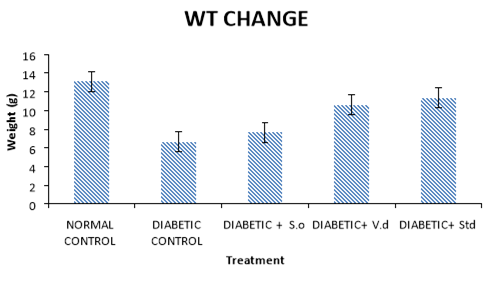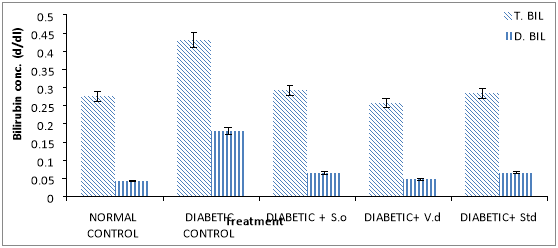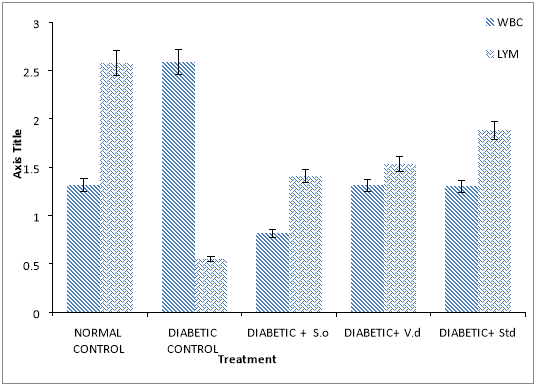Journal of
eISSN: 2473-0831


Research Article Volume 4 Issue 2
Correspondence: Yakubu OE, Department of Biochemistry, Faculty of Pure and Applied Sciences, Federal University Wukari, Nigeria
Received: February 10, 2017 | Published: February 22, 2017
Citation: Yakubu OE, Otitoju O, Okwara D (2017) Comparative Hepatoprotective and Haematological Effects of the Ethanol Extracts of the Leaves of Vitex Doniana and Senna occidentalis in Alloxan-Induced Diabetes in Male Wistar Rats. J Anal Pharm Res 4(2): 00099. DOI: 10.15406/japlr.2017.04.00099
Aim: The goal of this study is to determine the Antidiabetic and hepatoprotective effects of the ethanol extracts of the leaves of Vitex doniana and Senna occidentalis in alloxan-induced diabetes in male Wistar rats.
Materials and methods: Thirty (30) male albino rats were randomly divided into five groups consisting of six animals each. Diabetes was induced using intraperitoneal administration 150mg/kg body weight of alloxan and treatment was carried out over a period of 14days. The first group served as the normal control and received only normal feed and water, Group 2: diabetic rats without treatment. Group 3: diabetic ratstreated with 100mg/kg ethanol extract of Vitex doniana. Group 4: diabetic rats treated with 100mg/kg ethanol extract of Senna occidentalis. And group 5: diabetic rats treated with 10mg/kg Glibenclamide.
Results: Glucose level, Thiobarbituric acid reactive substances (TBARS), bilirubin, alanine aminotransferase, aspartate aminotransferase and full blood count were significantly (p < 0.05) changed in rats treated with Alloxan (150mg/kg bw) while treatment with the respective extracts significantly changed the levels of these parameters to normal. The results obtained indicate that the extracts were beneficial in ameliorating damages caused by Alloxan in male rats.
Conclusion: This study clearly showed the hepatoprotective and haematological effects of the ethanol extracts of the leaves of Vitex doniana and Senna occidentalis in alloxan-induced diabetes in male Wistar rats. The obtained results indicated that Vitex doniana and Senna occidentalis at about (500g) bw would be a good natural source for protection against diabetes-induced liver and blood toxicities.
Keywords: diabetes, liver function, wister rats, ethanol extract, vitex doniana, senna occidentalis, alloxan
AST, aspartate aminotransferase; ALT, alanine aminotransferase; TBARS, thiobarbituric acid reactive substances; FBS, fasting blood sugar; FBG, fasting blood glucose; S-GLUT, sodium glucose co-transporter; NIPRD, national institute for pharmaceutical research; RBC, red blood cell; PVC, packed cell volume; Hb, haemoglobin; LYMP, lymphocytes; WBC, white blood cell; ANOVA, analysis of variance; TCA, tricarboxylic acid
Diabetes mellitus is one of the most familiar chronic diseases associated with carbohydrate metabolism. It is also an indication of co-morbidities such as obesity, hypertension and hyperlipidemia which are metabolic complications of both clinical and experimental diabetes. Despite the fact that diabetes mellitus has high prevalence, morbidity, and mortality globally, it is regarded as a non-curable but controllable disease. Different synthetic drugs, plant remedies and dietary modifications play an efficient role in the reduction of the suffering that it causes. The potential role of medicinal plants as hypoglycemic agents has been reviewed by several researchers.1,2 Pancreas is the primary organ involved in sensing the organism's dietary and energetic states via glucose concentration in the blood and in response to elevated blood glucose, insulin is secreted.
Alloxan is one of the usual substances used for the induction of diabetes mellitus apart from streptozotocin. Alloxan has a destructive effect on the beta cells of the pancreas. Alloxan causes a massive reduction in insulin release by the destruction of β-cells of the islets of langherhans, thereby inducing hyperglycemia. Insulin deficiency leads to various metabolic alterations in the animals viz. increased cholesterol, increased levels of several blood parameters, alkaline phosphate and transaminases.3,4 Plants which have flavonoids, terpenoids, alkaloids, and glycosides have antioxidant activity and most of which have been claimed to possess antidiabetic effect. Flavonoids present in plants regenerate the damaged beta cells of pancreases, and the polyphenolic compounds. Saponin present in the plants inhibit glucose transport by inhibiting sodium glucose co-transporter-1 (S-GLUT-1) in intestine.5,6 Yakubu et al.,7,8 have reported some of the pharmacological uses of these plants respectively. Hence, the desire to evaluate the comparative hepatoprotective and haematological effects of these plants.
Collection and preparation of plant materials
The fresh leaves of V. doniana and S. occidentalis were collected from its natural habitat in Ankpa, Kogi State, and were identified and authenticated by the ethnobotanist in the Department of Medicinal Plant Research and Traditional Medicine of the National Institute for Pharmaceutical Research and Development (NIPRD), Abuja, Nigeria. The plant materials were dried in the laboratory at room temperature and pulverized using laboratory mortar and pestle.
Ethanol extraction
About (500g) of each pulverized sample were soaked separately in 2.5L (1:5w/v) of ethanol for 24hr. The extracts were filtered under reduced pressure using filter paper, membrane filter and vacuum pump. They were concentrated using rotary evaporator under reduced pressure respectively. The extracts were reconstituted freshly in distilled water at appropriate concentrations for the various experimental doses using the equation of Tedong et al.,9
.
Animal management
Male albino rats (7 to 8weeks old) were purchased from the animal house of the Department of Medical Biochemistry, Cross River University of Technology, Calabar, Nigeria. They were acclimatized for two weeks prior to commencement of experiment. They were kept at room temperature and maintained ad libitum on growers mash (feed) and weighed prior to experiment.
Induction of diabetes
Diabetes was induced by subjecting the animals to over-night fasting, followed by intraperitoneal injection of alloxan with a single dose of 150mg/kg body weight. Alloxan is capable of inducing hyperglycermia as a result of massive pancreative insulin release, after 72hrs the animal were tested and confirmed to be diabetic. Animals with FBS 160mg/dl and above were selected for the study.
Experimental design
Thirty (30) male albino rats were divided into five groups consisting of six animals each. Out of the five groups four groups were made diabetic as described below.
Treatment of diabetic and normal rats was carried out orally for 14days.
Sample collection and processing
At the end of administration, the animals fasted overnight, they were weighed using a standard weighing balance, anaesthetized under chloroform anaesthesia and quickly brought for sacrifice. Blood samples were collected through cardiac puncture. The organs (kidney and liver) were surgically removed, weighed and immediately rinsed with ice cold normal saline and kept in the refrigerator prior to analysis. Blood sample of about 3-4mls was collected via cardiac puncture and separated into a plane tube and heparinized tube for chemistry and haematological analysis. The sample for chemistry analysis was centrifuged using a standard centrifuge at the speed of 3500rpm for 10minutes in order to obtain serum from whole blood.
Determination of thiobarbituric acid reactive substance (TBARS)
This was carried out according to the method described by Frode et al.,10 10g (10%) of TCA and 0.67g (0.67%) TBA was weighed and dissolved in to 100ml of distilled water for use. About 100µl of tissue homogenate was added into a test tube containing 2ml of TCA. 2ml of TBA was added and mixed thoroughly. It was incubated at 80oC for 30minutes in water bath and cooled immediately under ice. The sample mixture was then centrifuged at 3,500rpm for 10minutes and the absorbance was read immediately at 535mm using a UV/VIS spectrophotometer.
Assay for liver enzymes
Aspartate aminotransferase (AST), Alanine aminotransferase (ALT) and Serum alkaline phosphatase were determined using assay kits (Agape Laboratories Ltd, UK).
Serum bilirubin
This was determined colorimetrically according to the method described by Jendrassic et al.,11 using assay kits (Agape Laboratories Ltd, UK).
Determination of haematological parameters
The total Red blood cell count (RBC), packed cell volume (PCV), haemoglobin concentration (Hb), lymphocyte concentration (LYM), White blood cell count (WBC) and Platelet count were determined using Abacus 280 auto haematology analyzer.
Statistical analysis
All the values estimations were expressed as mean ± standard deviation and analyzed for ANOVA and post hoc Duncan’s -test using SPSS. Differences between groups were considered significant at P <0.05 levels.
Weight changes in animals were observed in both the control and treated group (Figure 1). Group two animals (control group) had the lowest weight followed by the diabetic rats treated with Senna occidentalis extract and finally Vitex doniana and glibenclamide.

Figure 1 Effect of ethanol extracts of the leaves of Vitex doniana and Senna occidentalis on body weight.
Liver and kidneys thiobarbituric acid reactive substances (TBARS) levels
Significant increase (p<0.05) was observed in the TBARS levels of the diabetic control group (Figure 2) compared to normal control. Treatment of diabetic animals with the extracts and glibenclamide caused significant decrease (p<0.05) in TBARS concentration in both the liver and kidneys of diabetic control group.
Serum liver enzyme activities
There was significant increase (p<0.05) in liver enzyme (ALT, AST, ALP) activities owing to diabetic condition caused by alloxanization (Figure 3) compared to normal control group. Treatment of diabetic rats with aqueous and ethanol extracts caused significant decrease (p<0.05) in the enzyme activities compared to the diabetic control group. Glibenclamide treatment of diabetic rats also caused significant decrease (p<0.05) in the enzyme activities compared with the diabetic control. However, the extracts elicited more effects than the glibenclamide treatment, though not statistically significant (p<0.05).

Figure 3 Effect of ethanol extracts of the leaves of Vitex doniana and Senna occidentalis on Serum liver enzyme activities.
Serum bilirubin concentration
Treatment of diabetic rats with the extracts caused significant decrease (p<0.05) in serum bilirubin concentration compared with the diabetic control (Figure 4). The decrease in serum total bilirubin concentration caused by glibenclamide was not statistically significant (p<0.05) compared with the diabetic control.

Figure 4 Effect of ethanol extracts of the leaves of Vitex doniana and Senna occidentalis on Serum bilirubin concentration.
Full blood count: white blood count (WBC), lymphocyte (LYM), red blood count (RBC) and platelets (PLT)
In the full blood count, diabetic condition caused significant increase (p<0.05) in WBC and PLT in group 2 (Figure 5) compared to the normal control in group 1. Treatment of diabetic rats with aqueous extract and glibenclamide in group 3 and 5 had no significant difference (p<0.05) from the diabetic control group, except the group treated with ethanol extract i.e for WBC, but PLT was significantly lower (p<0.05) in aqueous extract and glibenclamide. Unlike WBC, LYM and RBC levels were significantly lower (p<0.05) in diabetic control compared to the normal control. Hence treatment with extracts as well as glibenclamide caused significant increase in diabetic control in LYM and RBC levels compared to the diabetic control group.

Figure 5 Effect of ethanol extracts of the leaves of Vitex doniana and Senna occidentalis on Full Blood Count Levels (WBC, LYM, RBC and PLT).
Packed Cell Volume (PCV) and haemoglobin (Hb) concentrations
PCV and Hb levels were significantly lower (p<0.05) in diabetic control compared to the normal control (Figure 6). Hence treatment with extracts as well as glibenclamide caused significant increase in diabetic control in PCV and Hb levels compared to the diabetic control group.
In diabetic condition, elevated blood glucose, reduction in body weight, polyuria, polydipsia and polyphagia are commonly observed. In the present study, induction of diabetes by alloxan produced increase in blood glucose level, decrease in body weight and polyuria. In diabetic rats, observed reduction in body weight was possible due to catabolism of fats and protein.12 The administration of ethanol extracts improved body weight compared to diabetic control rats which indicates preventive effect of extract on degradation of structural proteins.13 Earlier, many plants have been studied for their hypoglycemic and insulin release stimulatory effects.14,15
In diabetes, elevated levels of serum urea and creatinine are observed which may be due to renal damage caused by abnormal glucose regulation or elevated glucose and glycosylated protein tissue levels.16 In present study, significant increase in serum urea and creatinine levels were observed in diabetic rats compared to normal control rats which indicate impaired renal function in diabetic rats. The treatment with ethanol extract of Vitex doniana and Senna occidentalis leaf lowered the above parameters significantly compared to diabetic control rats and it showed protective effect of ethanol extract of Vitex doniana and Senna occidentalis leaf on the kidneys.
Also, increased serum AST, ALT and ALP levels were reported in diabetes and it may be due to liver dysfunction.17 In this study, increased level of AST, ALT and ALP was observed in alloxan-induced diabetic rats which may have occurred by leakage of enzymes from the liver cytosol into the blood stream; it represents the toxicity of alloxan on liver. Diabetic rats treated with ethanol extract of Vitex doniana and Senna occidentalis leaf significantly reduced both enzyme levels which represents the protective action of ethanol extract of Vitex doniana and Senna occidentalis leaf in diabetic condition.
In the present study, the administration of Vitex doniana and Senna occidentalis leaf extracts to alloxan induced hyperglycemic rats demonstrated prominent reduction in blood sugar level, normalization of serum biochemical profile including lipid content, as compared to alloxan control rats. Several authors reported that flavonoids, steroids/terpenoids, phenolic acids are known to be bioactive antidiabetic principles.18,19 Flavonoids are known to regenerate the damaged beta cells in the alloxan induced diabetic rats and acts as insulin secretagogues.20 In the present study, the phytochemical analysis of ethanol extract of Vitex doniana and Senna occidentalis leaf clearly prints out the presence of above said active principles. The preliminary investigation on the antidiabetic and hepatoprotective efficacy of ethanol extract of Vitex doniana and Senna occidentalis leaf will be significant to proceed further in this path for the isolation of active principles responsible for the antidiabetic activity.
Loss in body weight was observed in alloxan-induced diabetes mellitus in rats and was controlled by treatment with ethanolic extract of the whole plant of Vitex doniana and Senna occidentalis. Administration of an ethanolic extract of the whole plant of Vitex doniana and Senna occidentalis to diabetic rats resulted in an increase in body weight compared to diabetic rats. The present study findings suggested that Vitex doniana and Senna occidentalis treatment has positive effect on maintaining body weights in diabetic rats. The protective effect of plant fraction on body weight of diabetic rats may be due to its ability to reduce hyperglycemia. A gradual increase in body weights of glibenclamide treated groups was similar to that of normal control rats. alloxan-induced diabetes mellitus was characterized by severe loss of body weight due to increased muscle wasting in diabetes.21 Alloxan is a glucosamine-nitrosourea derived from Streptomyces achromogenes (gram-positive bacterium), and it is used for the treatment of pancreatic beta cell carcinoma. Alloxan inducing diabetes, hyperinsulinemia, or hyperglycemia by damaging the pancreatic beta cells.22
Plant which have flavonoids, terpenoids, alkaloids, and glycosides have antioxidant activity and claimed to possess antidiabetic effect. Flavonoids present in the plant regenerate the damaged beta cells of pancreases, and the polyphenolic compounds and saponin present in the plants inhibit glucose transport by inhibiting sodium glucose co-transporter-1 (S-GLUT-1) in intestine. Hepatoprotective effect of the ethanolic extract of the whole plant of Vitex doniana and Senna occidentalis might be due to presence of flavonoids, polyphenolic compounds, and saponin in the extract.
This study clearly showed the hepatoprotective and haematological effects of the ethanol extracts of the leaves of Vitex doniana and Senna occidentalis in alloxan-induced diabetes in male Wistar rats. The obtained results indicated that Vitex doniana and Senna occidentalis would be a good natural source for protection against diabetes and liver toxicity. On basis of the present and pervious study reports, Vitex doniana and Senna occidentalis have significant hepatoprotective and haematological activities against complications of alloxan-induced diabetes mellitus. The action may be due to presence of flavonoids, and further investigation is required to rollout the bioactive compound present in the plant.
None.
Author declares there are no conflicts of interest.
None.

©2017 Yakubu, et al. This is an open access article distributed under the terms of the, which permits unrestricted use, distribution, and build upon your work non-commercially.